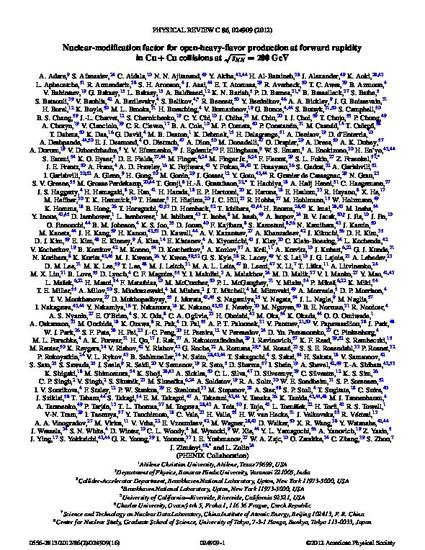
Article
Nuclear-modification factor for open-heavy-flavor production at forward rapidity in Cu plus Cu collisions at root s(NN)=200 GeV
Physical Review C
Document Type
Article
Publication Version
Published Version
Publication Date
8-20-2012
DOI
10.1103/PhysRevC.86.024909
Abstract
Background: Heavy-flavor production in p + p collisions is a good test of perturbative-quantum-chromodynamics (pQCD) calculations. Modification of heavy-flavor production in heavy-ion collisions relative to binary-collision scaling from p + p results, quantified with the nuclear-modification factor (R-AA), provides information on both cold-and hot-nuclear-matter effects. Midrapidity heavy-flavor R-AA measurements at the Relativistic Heavy Ion Collider have challenged parton-energy-loss models and resulted in upper limits on the viscosity-entropy ratio that are near the quantum lower bound. Such measurements have not been made in the forward-rapidity region. Purpose: Determine transverse-momentum (p(T)) spectra and the corresponding R-AA for muons from heavy-flavor meson decay in p + p and Cu + Cu collisions at root s(NN) = 200 GeV and y = 1.65. Method: Results are obtained using the semileptonic decay of heavy-flavor mesons into negative muons. The PHENIX muon-arm spectrometers measure the p(T) spectra of inclusive muon candidates. Backgrounds, primarily due to light hadrons, are determined with a Monte Carlo calculation using a set of input hadron distributions tuned to match measured-hadron distributions in the same detector and statistically subtracted. Results: The charm-production cross section in p + p collisions at root s = 200 GeV, integrated over p(T) and in the rapidity range 1.4 < y < 1.9, is found to be d(sigma e (e) over bar)/dy = 0.139 +/- 0.029 (stat)(-0.058)(+0.051) (syst) mb. This result is consistent with a perturbative fixed-order-plus-next-to-leading-log calculation within scale uncertainties and is also consistent with expectations based on the corresponding midrapidity charm-production cross section measured by PHENIX. The R-AA for heavy-flavor muons in Cu + Cu collisions is measured in three centrality bins for 1 < p(T) < 4 GeV/c. Suppression relative to binary-collision scaling (R-AA < 1) increases with centrality. Conclusions: Within experimental and theoretical uncertainties, the measured charm yield in p + p collisions is consistent with state-of-the-art pQCD calculations. Suppression in central Cu + Cu collisions suggests the presence of significant cold-nuclear-matter effects and final-state energy loss.
Copyright Owner
American Physical Society
Copyright Date
2012
Language
en
File Format
application/pdf
Citation Information
Andrew Adare, Nathan Conrad Grau, John C. Hill, John G. Lajoie, et al.. "Nuclear-modification factor for open-heavy-flavor production at forward rapidity in Cu plus Cu collisions at root s(NN)=200 GeV" Physical Review C Vol. 86 Iss. 2 (2012) p. 024909 Available at: http://works.bepress.com/craig-ogilvie/84/

This is an article from Physical Review C 86 (2012): 024909-1, doi:10.1103/PhysRevC.86.024909. Posted with permission.